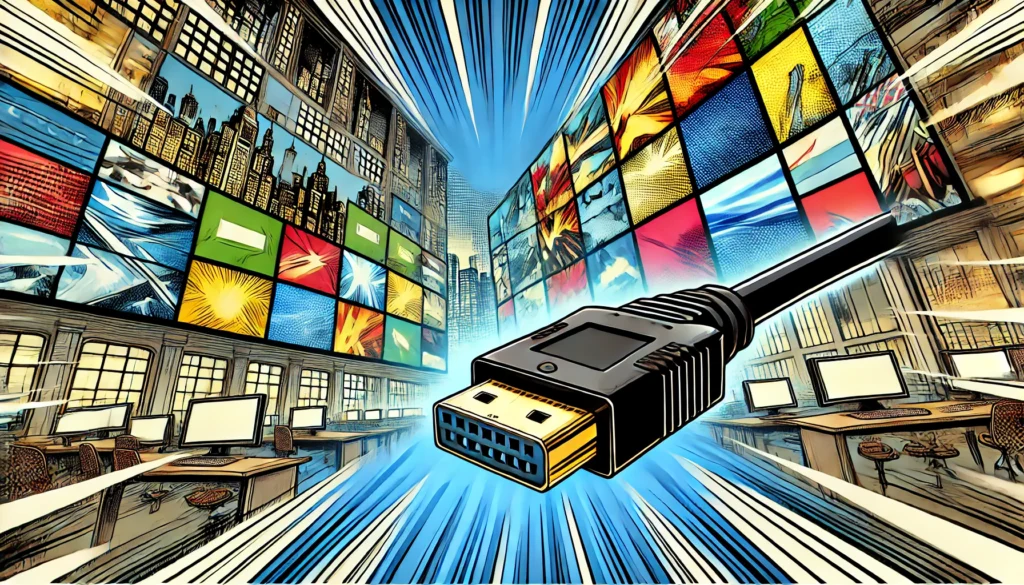In the arena of digital display technology, DisplayPort stands out as a powerful and versatile connection standard designed to deliver high-definition video and audio over a single cable. Ideal for computer monitors, video projectors, and other high-resolution displays, DisplayPort enhances your viewing experience with superior performance. This article explores what DisplayPort is, how it works, and its advantages over other display connection types.
Table of Contents
2. Key Features of DisplayPort
4. DisplayPort vs. HDMI: What’s the Difference?
5. Applications of DisplayPort
6. Benefits of Using DisplayPort
1. What is DisplayPort?
DisplayPort is a digital display interface developed by the Video Electronics Standards Association (VESA). Launched in 2006, it primarily connects a video source to a display device like a computer monitor, offering high bandwidth to support superior video and audio quality. DisplayPort is widely used in the computer industry, particularly where high-definition content and large screens are prevalent.
2. Key Features of DisplayPort
- High Resolution: Supports resolutions up to 8K and beyond, making it suitable for professional and home environments where high visual fidelity is crucial.
- High Refresh Rates: Capable of delivering high refresh rates, essential for gaming and professional video editing where smooth motion is critical.
- Multi-Stream Technology (MST): Allows multiple monitors to be connected through a single DisplayPort connection, streamlining workspace setups and enhancing productivity.
- Audio and Video: Transmits both audio and video simultaneously, reducing cable clutter and simplifying connections.
- Backward Compatibility: Compatible with older standards like VGA, DVI, and HDMI through the use of simple adapters.
3. How Does DisplayPort Work?
DisplayPort uses a packetized data transmission system similar to Ethernet or USB. This method involves sending data in discrete packets, which allows for high-speed digital transmission. This technology also supports both external (standard cables and connectors) and internal (direct motherboard-to-display connections) display connections.
4. DisplayPort vs. HDMI: What’s the Difference?
While HDMI is widely used in home entertainment systems for audio and video connections, DisplayPort is primarily designed for computer displays and professional IT environments. Here are some distinctions:
- Higher Bandwidth: DisplayPort generally supports higher bandwidth compared to HDMI, which means it can handle higher resolutions and faster refresh rates more effectively.
- Daisy Chaining: Unlike HDMI, DisplayPort supports daisy chaining up to several monitors from a single output.
- Audio/Video Sync: DisplayPort is designed to handle high-performance video and audio simultaneously without sync issues, making it ideal for professional video production and gaming.
5. Applications of DisplayPort
- Professional Monitors: Used widely in high-resolution monitors for graphic design, video editing, and other professional applications that require precise colour and detailed imagery.
- Gaming: Gamers benefit from the high refresh rates and adaptive sync features of DisplayPort, which reduce tearing and improve overall game play.
- Video Walls: DisplayPort’s ability to support multiple displays from a single connection makes it ideal for creating stunning video walls in retail and entertainment venues.
6. Benefits of Using DisplayPort
- Superior Video Quality: Supports the latest standards in resolution, refresh rates, and color depths.
- Flexibility: The ability to connect multiple displays and transmit high-quality audio and video over a single cable simplifies setups.
- Future-Proof: As resolutions and screen technologies advance, DisplayPort’s bandwidth capacity makes it a future-proof choice for high-definition video output.
Final Thoughts
DisplayPort is a robust, high-performance interface that significantly enhances the capabilities of digital displays. Whether you’re setting up a multi-monitor workstation, a professional video editing suite, or a high-end gaming rig, DisplayPort provides the reliability, performance, and quality needed to elevate your screen experience.
By understanding the functionalities and benefits of DisplayPort, users can make informed decisions about their digital display setups, ensuring compatibility, performance, and enjoyment of high-definition content.
